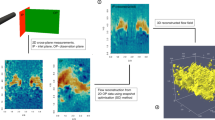Abstract
Motivated by the mid-latitude atmospheric circulation, we develop a system that uses observations from a differentially heated rotating annulus experiment to constrain a numerical simulation in real-time. The coupled physical-numerical system provides a tool to rapidly prototype new methods for state and parameter estimation, and facilitates the study of prediction, predictability, and transport of geophysical fluids where observations or numerical simulations would not independently suffice. A computer vision system is used to extract measurements from the physical simulation, which constrain the model-state of the MIT general circulation model in a hybrid data assimilation approach. Using a combination of parallelism, domain decomposition and an efficient scheme to select ensembles of model-states, we show that estimates that effectively track the fluid-state can be produced. To the best of our knowledge, this is the first realtime coupled system for this laboratory analog of planetary circulation.










Similar content being viewed by others
Notes
The state for assimilation consists of the horizontal velocities and temperature. Vertical velocity is implicit, pressure is diagnostic and salinity is unrepresented.
This formulation is discussed for its simplicity. Other variations, e.g. explicit inverse, will be useful for small state sizes.
\({\bar{\mathbf{V}}}^{\rm f} = \frac{1}{S}\sum_{i=1}^S {\mathbf V}^{\rm f}[:,i]\)
Except near annulus boundaries, where the window is off-center.
A large number of matrices C ij are identical, thus saving storage costs.
References
Arakawa A, Lamb V (1977) Computational design of the basic dynamical processes of the ucla general circulation model. Methods Comput Phys 17:174–267 (Academic Press)
Demmel JW, Demmel JW, Heath MT, Heath MT, Vorst HAVD, Vorst HAVD (1997) Applied numerical linear algebra. SIAM
Evensen G (2003) The ensemble kalman filter: theoretical formulation and practical implementation. Ocean Dyn 53:342–367
Geisler JE, Pitcher EJ, Malone RC (1983) Rotating-fluid experiments with an atmospheric general circulation model. J Geophys Res 88(C14):9706–9716
Gelb A (1974) Applied optimal estimation. MIT Press, Cambridge, MA, USA
Hide R (1958) An experimental study of thermal convection in a rotating liquid. Phil Trans Roy Soc A250:441–478
Lee C (1993) Basic instability and transition to chaos in a rapidly rotating annulus on a beta-plane. PhD thesis, University of California, Berkeley
Lorenz EN (1963) Deterministic nonperiodic flow. J Atmos Sci 20:130–141
Marshall J, Adcroft A, Hill C, Perelman L, Heisey C (1997a) A finite-volume, incompressible navier stokes model for studies of the ocean on parallel computers. J Geophys Res 102(C3):5753–5766
Marshall J, Hill C, Perelman L, Adcroft A (1997b) Hydrostatic, quasi-hydrostatic and nonhydrostatic ocean modeling. J Geophys Res 102(C3):5733–5752
Morita O, Uryu M (1989) Geostrophic turbulence in a rotating annulus of fluid. J Atmos Sci 46(15):2349–2355
Ott E, Hunt BR, Szunyogh I, Zimin A, Kstelich E, Corazza M, Kalnay E, Patil DJ, Yorke JA (2003) A local ensemble kalman filter for atmospheric data assimilation. Technical report. arXiv:physics/0203058 v4, University of Maryland
Pedlosky J (1987) Geophysical fluid dynamics. Springer, New York
Ravela S, Hansen J, Hill C, Marshall J, Hill H (2003) On ensemble-based multiscale assimilation. In: European geophysical union annual congress
Ravela S, Marshall J, Hill C, Wong A, Stransky S (2007) A real-time observatory for laboratory simulation of planetary circulation. In: Lecture notes in computer ccience, vol 4487, pp 1155–1162
Read PL (2003) A combined laboratory and numerical study of heat transport by baroclinic eddies and axisymmetric flows. J Fluid Mech 489:301–323
Read PL, Bell MJ, Johnson DW, Small RM (1992) Quasi-periodic and chaotic flow regimes in a thermally driven, rotating fluid annulus. J Fluid Mech 238:599–632
Read PL, Thomas NPJ, Risch SH (2000) An evaluation of eulerian and semi-lagrangian advection schemes in simulations of rotating, stratified flows in the laboratory. part i: axisymmetric flow. Mon Weather Rev 128:2835–2852
Sirovich L (1987) Turbulence and the dynamics of coherent structures, part 1: cohrerent structures. Q Appl Math 45(3):561–571
Sweby PK (1984) High resolution schemes using flux-limiters for hyperbolic conservation laws. SIAM J Numer Anal 21:995–1011
Tajima T, Nakamura T (2003) Experiments to study baroclinic waves penetrating into a stratified layer by a quasi-geostrophic potential vorticity equation. Experiments in Fluids 34(6):744–747
von Larcher T, Egbers C (2005) Experiments on transitions of baroclinic waves in a differentially heated rotating annulus. Nonlinear Process Geophy 12:1044–1041
Wunsch C (1996) The Ocean Circulation Inverse Problem. Cambridge University Press, Cambridge, UK
Young R, Read P (2006) Breeding vectors in the rotating annulus as a measure of intrinsic predictability. In: Royal Met. Soc. Annual Student Conference
Acknowledgments
This work is funded by CNS-0540259 and NSF Grant CNS-0540248. The authors thank Ryan Abernathy for helping with the hardware platform development.
Author information
Authors and Affiliations
Corresponding author
Rights and permissions
About this article
Cite this article
Ravela, S., Marshall, J., Hill, C. et al. A realtime observatory for laboratory simulation of planetary flows. Exp Fluids 48, 915–925 (2010). https://doi.org/10.1007/s00348-009-0752-0
Received:
Revised:
Accepted:
Published:
Issue Date:
DOI: https://doi.org/10.1007/s00348-009-0752-0




